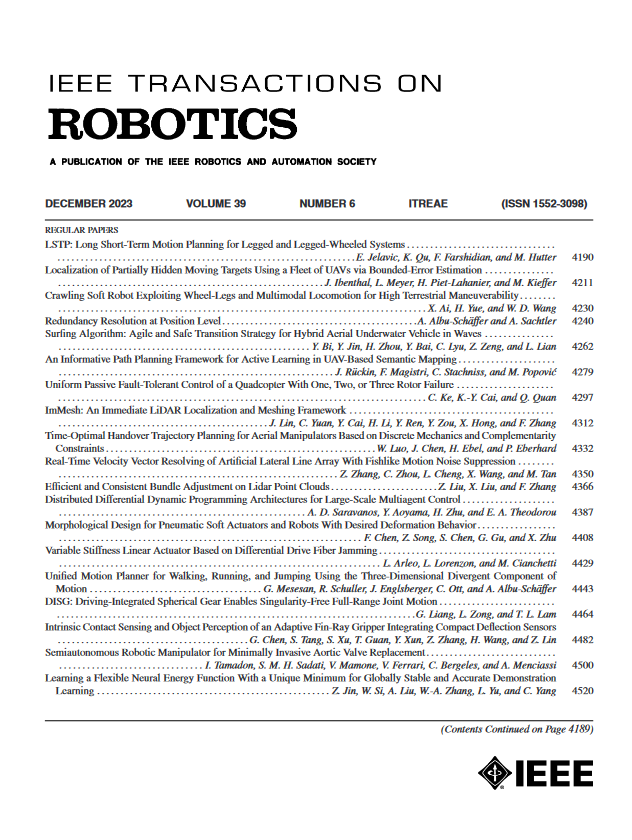基于几何建模的计算机视觉在髋关节外装中的环境感知控制
IF 9.4
1区 计算机科学
Q1 ROBOTICS
引用次数: 0
摘要
人类利用视觉输入等感官方式,根据周围环境调整自己的运动模式。这种情境知情的自适应运动行为增加了将计算机视觉(CV)算法集成到机器人辅助技术中的兴趣,标志着向情境感知控制的转变。然而,到目前为止,这种集成很少实现,目前的方法主要依赖于数据驱动的方法。在这项研究中,我们引入了一种新的软臀外装控制框架,采用基于捕获场景几何建模的物理信息CV方法,用于楼梯和水平行走期间的辅助调谐。这种方法有望提供一种可行的解决方案,它的计算效率更高,而且不依赖于训练样例。在包括水平行走和楼梯的路径上对六名受试者的控制器进行评估,我们实现了93.0\pm 1.1\%的总体检测精度。与非视觉辅助相比,基于cv的辅助提供了更大的代谢益处,相对于在没有辅助的情况下,在楼梯上升(-18.9 \pm 4.1%美元vs -5.2 \pm 4.1%美元)和下降(-10.1 \pm 3.6\%美元vs -4.7 \pm 4.8\%美元)期间,能量减少更大。这样的结果是设备自适应特性的结果,由上下文感知控制器实现,允许更有效的行走支持,即,与没有视觉辅助调制的情况相比,在上楼梯时辅助扭矩显着增加(+33.9\pm 8.8\%$),在下楼梯时减少(-17.4\pm 6.0\%$)。这些结果突出了该方法的潜力,促进了辅助机器人中有效的实时嵌入式应用。本文章由计算机程序翻译,如有差异,请以英文原文为准。
Leveraging Geometric Modeling-Based Computer Vision for Context Aware Control in a Hip Exosuit
Human beings adapt their motor patterns in response to their surroundings, utilizing sensory modalities such as visual inputs. This context-informed adaptive motor behavior has increased interest in integrating computer vision (CV) algorithms into robotic assistive technologies, marking a shift toward context aware control. However, such integration has rarely been achieved so far, with current methods mostly relying on data-driven approaches. In this study, we introduce a novel control framework for a soft hip exosuit, employing instead a physics-informed CV method grounded on geometric modeling of the captured scene for assistance tuning during stairs and level walking. This approach promises to provide a viable solution that is more computationally efficient and does not depend on training examples. Evaluating the controller with six subjects on a path comprising level walking and stairs, we achieved an overall detection accuracy of $93.0\pm 1.1\%$ $-18.9 \pm 4.1\%$ $-5.2 \pm 4.1\%$ $-10.1 \pm 3.6\%$ $-4.7 \pm 4.8\%$ $+33.9\pm 8.8\%$ $-17.4\pm 6.0\%$
求助全文
通过发布文献求助,成功后即可免费获取论文全文。
去求助
来源期刊

IEEE Transactions on Robotics
工程技术-机器人学
CiteScore
14.90
自引率
5.10%
发文量
259
审稿时长
6.0 months
期刊介绍:
The IEEE Transactions on Robotics (T-RO) is dedicated to publishing fundamental papers covering all facets of robotics, drawing on interdisciplinary approaches from computer science, control systems, electrical engineering, mathematics, mechanical engineering, and beyond. From industrial applications to service and personal assistants, surgical operations to space, underwater, and remote exploration, robots and intelligent machines play pivotal roles across various domains, including entertainment, safety, search and rescue, military applications, agriculture, and intelligent vehicles.
Special emphasis is placed on intelligent machines and systems designed for unstructured environments, where a significant portion of the environment remains unknown and beyond direct sensing or control.
 求助内容:
求助内容: 应助结果提醒方式:
应助结果提醒方式:


